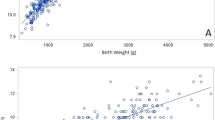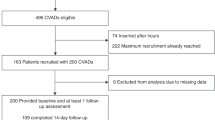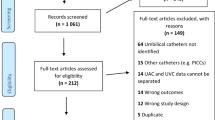Abstract
Objective
Central venous catheter (CVC) insertion is required for the management of sick neonates. Ultrasonography/targeted neonatal echocardiography (TNE) with/without normal saline (NS) flush is used to identify CVC position. The present study compared the visibility and safety of agitated saline (AS) with normal saline (NS) flush.
Study design
This prospective interventional study included 110 CVC insertions, both umbilical venous catheterization (UVC) and peripherally inserted central catheterization (PICC). Catheter position was monitored by real-time TNE.
Results
Overall visibility of catheter tip (combined UVC and PICC) was significantly better in AS (n = 55) compared with NS group (n = 55) [48/55 (87.2%) vs. 28/55 (50.9%); p < 0.0001]. Time to detect catheter tip by AS push was significantly less than that of NS push. There was no difference in the amount of saline flush required with either method. No major adverse effect was observed.
Conclusions
AS push can be used as a safe method to delineate CVC position in neonates.
This is a preview of subscription content, access via your institution
Access options
Subscribe to this journal
Receive 12 print issues and online access
$259.00 per year
only $21.58 per issue
Buy this article
- Purchase on SpringerLink
- Instant access to full article PDF
Prices may be subject to local taxes which are calculated during checkout



Similar content being viewed by others
References
Mutlu M, Aslan Y, Kul S, Yılmaz G. Umbilical venous catheter complications in newborns: a 6-year single-center experience. J Matern Fetal Neonatal Med. 2016;29:2817–22.
Chen HJ, Chao HC, Chiang MC, Chu SM. Hepatic extravasation complicated by umbilical venous catheterization in neonates: a 5-year, single-center experience. Pediatr Neonatol. 2020;61:16–24.
Greenberg M, Movahed H, Peterson B, Bejar R. Placement of umbilical venous catheters with use of bedside real-time ultrasonography. J Pediatr. 1995;126:633–5.
El-Maadawy SM, El-Atawi KM, Elhalik MS. Role of bedside ultrasound in determining the position of umbilical venous catheters. J Clin Neonatol. 2015;4:173–7.
Jain A, McNamara PJ, Ng E, El-Khuffash A. The use of targeted neonatal echocardiography to confirm placement of peripherally inserted central catheters in neonates. Am J Perinatol. 2012;29:101–6.
Sharma D, Farahbakhsh N, Tabatabaii SA. Role of ultrasound for central catheter tip localization in neonates: a review of the current evidence. J Matern-Fetal Neonatal Med. 2019;32:2429–37.
Michel F, Brevaut-Malaty V, Pasquali R, Thomachot L, Vialet R, Hassid S, et al. Comparison of ultrasound and X-ray in determining the position of umbilical venous catheter. Resuscitation. 2012;83:705–9.
Telang N, Sharma D, Pratap OT, Kandraju H, Murki S. Use of real-time ultrasound for locating tip position in neonates undergoing peripherally inserted central catheter insertion: a pilot study. Indian J Med Res. 2017;145:373–6.
Chang RK, Alejos JC, Atkinson D, Jensen R, Drant S, Galindo A, et al. Bubble contrast echocardiography in detecting pulmonary arteriovenous shunting in children with univentricular heart after cavopulmonary anastomosis. J Am Coll Cardiol. 1999;33:2052–8.
Gupta SK, Shetkar SS, Ramakrishnan S, Kothari SS. Saline contrast echocardiography in the era of multimodality imaging—importance of “bubbling it right”. Echocardiography. 2015;32:1707–19.
da Hora Passos R, Ribeiro M, Neves J, Rosa Ramos JG, Lima Oliveira AV, Barreto Z, et al. Agitated saline bubble−enhanced ultrasound for assessing appropriate position of hemodialysis central venous catheter in critically Ill patients. Kidney Int Rep. 2017;2:952–6.
Upadhyay J, Srivastava Y, Basu S, et al. Agitated saline contrast for delineation of central venous catheter tip in neonates. In: PEDICON 2020. Indian Academy of Pediatrics; 2020. Abstract 246, Abstract Booklet.
Verheij GH, te Pas AB, VEHJ Smits-Wintjens, Šràmek A, Walther FJ, Lopriore E. Revised formula to determine the insertion length of umbilical vein catheters. Eur J Pediatr. 2013;172:1011–5.
McCay AS, Elliott EC, Walden M. PICC Placement in the Neonate. N Engl J Med. 2014;370:e17.
Fleming S, Kim J. Ultrasound-guided umbilical catheter insertion in neonates. J Perinatol. 2011;31:344–9.
Young A, Harrison K, Sellwood MW. How to use… imaging for umbilical venous catheter placement. Arch Dis Child Educ Pr Ed. 2019;104:88–96.
Karber BCF, Nielsen JC, Balsam D, Messina C, Davidson D. Optimal radiologic position of an umbilical venous catheter tip as determined by echocardiography in very low birth weight newborns. J Neonatal-Perinat Med. 2017;10:55–61.
Chait PG, Ingram J, Phillips-Gordon C, Farrell H, Kuhn C. Peripherally inserted central catheters in children. Radiology. 1995;197:775–8.
Fricke BL, Racadio JM, Duckworth T, Donnelly LF, Tamer RM, Johnson ND. Placement of peripherally inserted central catheters without fluoroscopy in children: initial catheter tip position. Radiology. 2005;234:887–92.
Racadio JM, Doellman DA, Johnson ND, Bean JA, Jacobs BR. Pediatric peripherally inserted central catheters: complication rates related to catheter tip location. Pediatrics. 2001;107:E28.
van Schuppen J, Onland W, van Rijn R. Peripherally inserted central catheters. https://radiologyassistant.nl/pediatrics/lines-and-tubes-in-neonates. Accessed 31 Mar 2020.
Wen M, Stock K, Heemann U, Aussieker M, Küchle C. Agitated saline bubble-enhanced transthoracic echocardiography: a novel method to visualize the position of central venous catheter. Crit Care Med. 2014;42:e231–3.
Oleti T, Jeeva Sankar M, Thukral A, Sreenivas V, Gupta AK, Agarwal R, et al. Does ultrasound guidance for peripherally inserted central catheter (PICC) insertion reduce the incidence of tip malposition?—a randomized trial. J Perinatol 2019;39:95–101.
Franta J, Harabor A, Soraisham AS. Ultrasound assessment of umbilical venous catheter migration in preterm infants: a prospective study. Arch Dis Child Fetal Neonatal Ed. 2017;102:F251–5.
Singh A, Bajpai M, Panda SS, Jana M. Complications of peripherally inserted central venous catheters in neonates: lesson learned over 2 years in a tertiary care centre in India. Afr J Paediatr Surg. 2014;11:242–7.
Guimarães AF, Souza AA, Bouzada MC, Meira ZM. Accuracy of chest radiography for positioning of the umbilical venous catheter. J Pediatr (Rio J). 2017;93:172–8.
Brant R. Hypothesis Testing: Categorical Data - Estimation of Sample Size and Power for Comparing Two Binomial Proportions. In: Rosner B. (ed). Fundamentals of Biostatistics. https://www.stat.ubc.ca/~rollin/stats/ssize/b2.html. Accessed 30 Jun 2020.
Author contributions
JU, SB, YS, and PS conceptualized and designed the study, coordinated and supervised data collection, drafted the initial manuscript, and reviewed and revised the manuscript. KCD, SS, and RG performed the procedures, collected data, carried out the initial analyses, and reviewed and revised the manuscript. All authors approved the final manuscript as submitted and agree to be accountable for all aspects of the work.
Author information
Authors and Affiliations
Corresponding author
Ethics declarations
Conflict of interest
The authors declare that they have no conflict of interest.
Additional information
Publisher’s note Springer Nature remains neutral with regard to jurisdictional claims in published maps and institutional affiliations.
Supplementary information
Rights and permissions
About this article
Cite this article
Upadhyay, J., Basu, S., Srivastava, Y. et al. Agitated saline contrast to delineate central venous catheter position in neonates. J Perinatol 41, 1638–1644 (2021). https://doi.org/10.1038/s41372-020-0761-7
Received:
Revised:
Accepted:
Published:
Issue date:
DOI: https://doi.org/10.1038/s41372-020-0761-7
This article is cited by
-
Ultrasound-Guided Umbilical Venous Catheter Insertion to Reduce Rate of Catheter Tip Malposition in Neonates: A Randomized, Controlled Trial: Authors’ Reply
Indian Journal of Pediatrics (2022)
-
Ultrasound-Guided Umbilical Venous Catheter Insertion to Reduce Rate of Catheter Tip Malposition in Neonates: A Randomized, Controlled Trial: Correspondence
Indian Journal of Pediatrics (2022)



